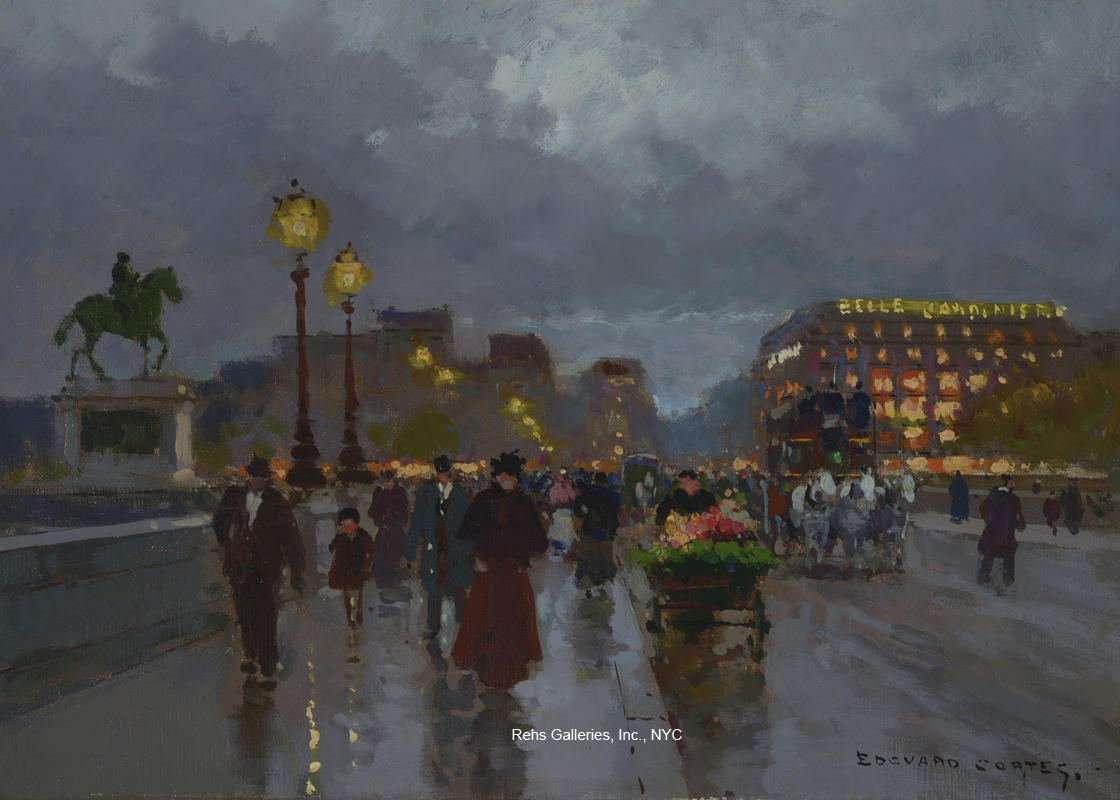Source: Pont-Neuf – another classic Paris street scene by Edouard Cortes (1882-1969) has made its way to a new home.
The Pont Neuf, (neuf meaning new, not nine) is Paris’ oldest remaining bridge that spans the Seine River.
The first stone was laid by Henri III in 1578, in the presence of the Queen Mother, Catherine de Médicis, under the direction of Baptiste Androuet du Cerceau (c.1545-1590). Shortly after construction began, there was a delay partially due to the Wars of Religion (a series of conflicts fought between Catholics and Huguenots (Protestants) during the sixteenth century), beginning around 1578. The bridge was finally finished in 1606 under the rule of Henry IV. In many respects, it is the first of the modern bridges in Paris and the most famous. Its design marks the end of the Middle Ages and linked the Louvre, the Abbaye de Saint Germain and the Left Bank in royal times.
The Pont Neuf was a phenomenal success and the enthusiasm for the bridge lasted two centuries. Not only was it wide, but it was the first stone bridge with no houses – allowing an unobstructed view of the Seine. It was recognized as a rallying point for all the sophisticated and vulgar pleasures of the capital; saying has it that one was sure to meet “a monk, a white horse and a street walker” there. The number of people seeking amorous encounters was certainly large; the number of shady characters, thieves, conmen and bandits of all kinds matched it. Additionally, small businesses flourished and public exhibitions by painters from the Académie Saint Luc were held on the bridge on the day of the Fête Dieu (Corpus Christi– the Feast of the Body of Christ). (Gaillard, 106-109)
The bridge, among the widest and most heavily trafficked bridges in Paris, has a total length of 278 meters and is 28 meters wide. There are 12 arches that span the widest part of the river, each featuring small headshaped sculpted decorations known as mascarons. Pavements were added to protect pedestrians from the mud and horses, and originally the turrets were constructed for vendors and street entertainers; today the turrets are used by pedestrians to rest and view the river.
The equestrian statue of Henri IV, constructed in 1614 at the request of Marie de Medici, sits where the bridge crosses over l’île de la Cité. The statue was destroyed during the French Revolution in 1792 and rebuilt in 1818 after the Monarchy was restored. Two statues of Napoléon were melted down to create the new statue of Henri IV, designed by the sculptor François-Frédéric Lemot (1772 – 1827). Lamot placed four boxes inside the statue, each contains a bit of history about Henri IV.
More recently, in September 1985, the modern artist Christo wrapped the bridge for two weeks leaving only the roadway uncovered.

